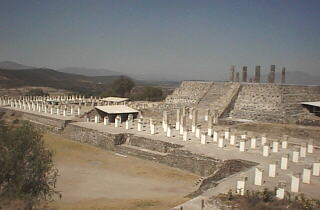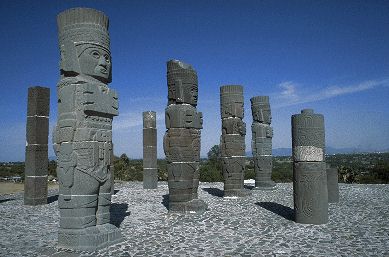| Chichen-Itzá |
| Palenque |
| Uxmal |
| Yaxchilàn |
| Tulum |
| Cobá |
| Dzibilchaltun |
| Teotihuacan |
| Tula |
| Home |
Tula (the ancient Tollan) is settled in the Valley of México and was the capital of the Toltecs (early Aztec ancestors) during the Tollan Phase. In its day, it was the largest city in Mesoamerica and in terms of its splendor, it was a city highly venerated by the Aztecs and was to follow Teotihuacan as the mightiest power in Mesoamerica.
As legend has it, the area in the Valley, located at the bottom of a ridge called El Salitre, provided reeds for basketry and mats and may have been the original inspiration for the name "Place of the Reeds."
Some scholars have referred to Tula
as a critical and highly influential empire, more so a political unit.
This political unit was forged through a combination of alliances, conquests,
and trade. It controlled most of central México and may even have
extended to distant Yucatan in southern México. This
reference also lends itself to the contention that the Toltecs of Tula
were a group of great military prowess. This is demonstrated in their architecture
and craft structures, specifically in Pyramid B, also called the Pyramid
of the Morning Star. It has carvings of eagles, jaguars, coyotes, and pumas
adorning its face and there are four massive warrior statues standing atop
the pyramid. This all suggests that they were demonstrating their ability,
skill, and power as great warriors.


The downfall of Tula plays a key role in the story of the ruler Quetzacoatl, for in spite of the version one may adhere to, the one thing that remains constant is that all of the happenings came out of Tula, and thus the civilization fell.